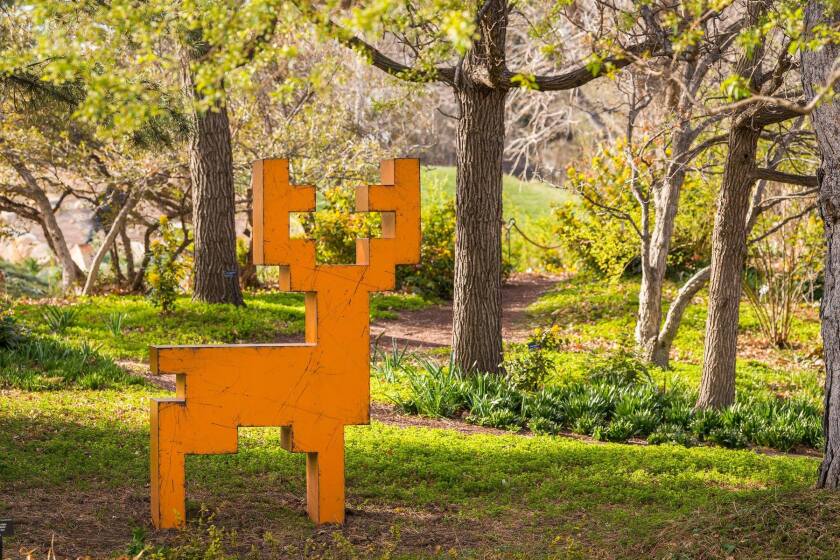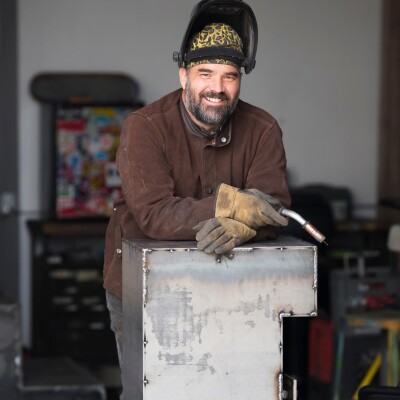Minimalism meets video games in Whiting’s pixel-based sculptures
Art and machinery have captivated Michael Whiting since he was a young child, when he drew pictures with his father. Inspired by the equipment on his grandfather’s farm in Washington State, Whiting especially liked capturing forklifts. He recalled one time when he was reprimanded by his grandmother for drawing a line on their freshly painted walls along the stairs. But when she saw the little forklift he drew at the end of the wall, she decided to leave it.
Throughout high school, Whiting spent his summers in construction, building houses in California. When he first came to the art program at BYU, he thought he would be a painter, but the possibilities for his art soon expanded. “When I took my first sculpture class with Neil Hadlock, it kind of just all came together,” Whiting said. “Combining building things and art — I realized that was the direction I wanted to take.”

Graduate School in New York
After experimenting with methods and materials during his undergraduate years, Whiting’s art became more focused in graduate school. Living in New York while earning an MFA at Pratt Institute was pivotal in his development as an artist. “In terms of art, seeing so much and interacting with so many people kind of changed the way I thought about making art,” Whiting said.
One significant event occurred when Whiting was visiting the Museum of Modern Art. A painting caught his eye that was reminiscent of the Atari video games he played as a child growing up in the eighties. But the artwork, “Broadway Boogie Woogie” by Piet Mondrian, was not inspired by video games at all. Painted in 1943, it predated Atari by a few decades.
The mental association Whiting formed between Mondrian’s painting and video games stuck with him; Mondrian was trying to express something, but through the simplest terms possible. Since that experience, Whiting’s work has explored the visual relationship between minimalism as an art movement and minimalism as a necessity in early video games. “There is a connection between this limited technology that was trying to express as much as it could, and a painter who was trying to reduce as much as he could,” Whiting said. “They came up with the same visual vocabulary, but for totally opposite reasons. I thought that was fascinating.” For his MFA thesis, Whiting presented raw, square-shaped steel panels as if they were found paintings, with heat marks from the steel processing. That was the beginning of his current work.

Public Artist
Today, Whiting balances work as a public artist, gallery artist, and adjunct instructor based in Southern California. In his primary line of work, he creates large public sculptures cut from plates of steel that now reside in major cities throughout the U.S., including Long Beach, Denver, Seattle, Salt Lake City, Albuquerque and Lansing, Michigan. "Earning a commission is a completely different process than working in the studio," Whiting said. He learned early on to only submit proposals he was excited about. “I don’t try to guess what they [i.e. cities or communities] want or what someone else would want to see there,” he said. “If I’m not excited about it, then I don’t apply. When I’m excited about it, that’s when I have the most success.” When approaching a new public sculpture project, Whiting researches the history and features of the location where the sculpture will live. He also considers how the artwork will cause people to interact with the area. “A lot of times it’s a wayfinder for people, or sometimes it’s more interactive, where people are moving around it,” Whiting said. “Different projects have different solutions.”
In addition to making public art, Whiting exhibits his work in museums and galleries around the country — such as the Plus Gallery in Denver, Causey Contemporary in New York and Edward Cella Art + Architecture in Los Angeles — and sells smaller, individual pieces, usually between one and five feet tall. His public sculptures, on the other hand, often stand more than 10 feet high and weigh between 5 and 10 thousand pounds.

“When these things get on that scale, and you’re interacting with something that looks digital, but instead of being on a screen it’s in this physical space, there’s something interesting about that,” Whiting said. “We’re no longer just imagining ourselves in a digital space, like in a video game, but it’s occupying our space. As the sculptures get bigger, that feeling is more pronounced.”
Life of a Sculpture
Whiting, who considers his art more dimensional painting than sculpture, begins each new project by sketching images pixel by pixel in Microsoft Paint, zoomed in at 800 percent and using the fewest squares possible. He then extrudes the image in the 3D modeling program Rhino to determine how the individual sides of each “pixel” fit together. Next, he laser-cuts and welds the steel plates using materials and techniques traditional to minimalist sculptures. Finally, he paints his sculptures with automotive paint, which he distresses to give them a worn look. “The paint is distressed to give a visual clue that these are not just minimal objects,” Whiting said. “The worn appearance acknowledges the history of ideas and movements that preceded these objects. It also distinguishes them from those same ideas and movements.”

The worn paint of Whiting’s sculptures also serves the practical purpose of being low-maintenance. If a public sculpture is defaced, for example, it is easy to sand down without causing too much damage. Despite some sanding down, however, signs of a sculpture’s history often remain, inciting mixed feelings from Whiting. In addition to making physical alterations to sculptures, some visitors figure out how to climb them or interact with them in other ways — becoming, in a sense, collaborators. Once Whiting is finished with a piece and presents it to the public, he no longer considers it exclusively his; it becomes part of the landscape that surrounds it. “I kind of have to let go,” Whiting said. “There’s something kind of great about that.”
